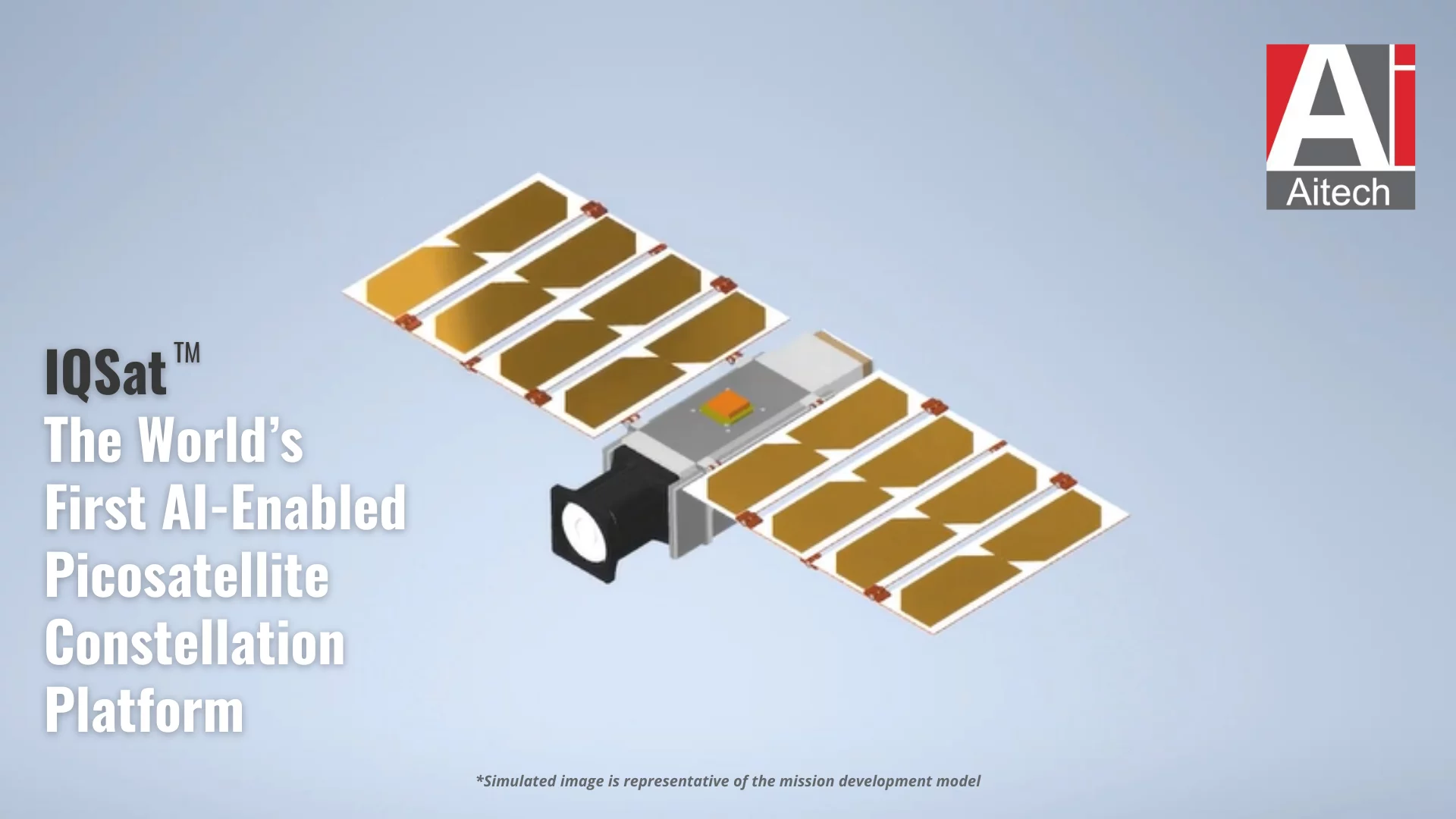News, W4S™
Aitech Unveils World’s First AI-Enabled Picosatellite Constellation Platform Transforming Space-Based Intelligence for Military, Defense, Public Safety, Agriculture and Infinite Other New Markets

April 7, 2025 – by Aitech
New IQSat Brings AI Capabilities in Low-Cost COTS Platform for Low Earth Orbit Missions Powering Rapid Actionable Data and Insights Previously Unattainable
COLORADO SPRINGS, Colo. (Space Symposium, Booth #612) – April 7, 2025 – Aitech, a leading provider of rugged embedded systems for military, aerospace and space platforms, today introduced the picosatellite (PicoSat) constellation platform, IQSat™. The IQSat is AI-enabled and includes Artificial Intelligence (AI) and Machine Learning (ML) from Intuidex, Inc. incorporated in Intuidex’s Watchman for Space™ (W4S™) product for detecting and providing insight on patterns and anomalies for a range of applications, including public safety, agriculture, military, defense, climate, biology and more.
Built on Aitech’s 30 years of electronics legacy and trillions of miles flown in space, the IQSat is small enough to be held in the palm of a hand and can be deployed in a constellation of five to thousands. Offering coverage previously unattainable, IQSat is powerful enough to deliver actionable pattern of life analysis, rapidly and frequently, from any desired point on Earth.
“Space-based infrastructure solves big problems and fuels big advancements on Earth. The new IQSat platform is integral to space accessibility by delivering low cost, rapid deployment constellations that provide access to actionable information quickly and frequently for infinite applications,” said Pratish Shah, U.S. general manager, Aitech. “Whether used for military and defense, environmental or agricultural applications, communications or scientific research, the flexibility, cost and availability of a solution like IQSat has not existed before – providing more accessibility to the power of space.”
Leveraging Intuidex’s Watchman for Space product, the IQSat offers Higher-Order Low-Resource Learning™ (HO-LRL™) in support of rapid do-it-yourself user-based modeling, detection and tracking, pattern of life and anomaly detection, and constellation operations capabilities that enable new uses across a range of markets:
- Military and Defense: With a low probability of intercept and low probability of detection, IQSat can deliver critical information on threat locations, directions and velocities in any area of interest at tactically significant update rates directly to the warfighter
- Space Situational Awareness: With flexible sensor options and constellation configurations, IQSat brings low-cost capability to detect space debris to prevent space collisions and monitor orbital traffic, as well as detect changes in satellite trajectories or potential anti-satellite threats
- Space Habitat: Placed in the vicinity of Space Habitats, IQSat can deliver temperature, radiation levels and other data variables to evaluate structure integrity by detecting micro-meteorite impacts and material degradation or external surveillance to detect space debris collision threats
- Public Safety: A low-cost LEO constellation of IQSats can provide rapid detection of remote areas to identify natural disasters such as floods and fires; assist in remote search and rescue operations through detection of objects, locations and movement directly to the rescuer; or monitor infrastructure surveillance of dams, bridges and other structures
- Agriculture: IQSat can assist farmers by delivering fast and frequent insight on soil, crops, disease, weather and other critical variables to help improve crop output
- Science and Research: A constellation of IQSats can provide researchers and scientists with a low-cost solution for tracking unique weather patterns, monitoring wildlife migrations around the world, tracking ocean currents and wildlife and many more capabilities
The IQSat provides mission flexibility for quick and cost-effective constellation design, reducing delivery time and cost of custom sensing satellites and constellation configurations. Leveraging Watchman for Space, the IQSat platform dynamically updates its incident, event, object or threat detection priorities to meet ever-changing mission needs through uplinked software and configuration driven by users. Additionally, IQSat offers the industry’s first common payload interface designed to host multiple payloads on a single flexible electrical and mechanical interface, allowing for quick and standardized designs to reduce cost, NRE and time to launch.
Aitech is showcasing the new IQSat PicoSat constellation platform at the Space Symposium in Colorado Springs, Colorado in booth #612 from April 7-10.
The IQSat platform will be available in Q4 2025 for mission development and ready for LEO flight in Q1 2026. Based on mission needs, the IQSat offers:
- Small size and ruggedized, standardized design for low-cost access to space
- Rapid development and deployment to create constellations in months
- Flexible sensor options to meet a range of mission needs
- The latest relevant information from areas of interest in minutes, with a constellation of thousands, frequent revisit rates and human-in-the-loop management in Watchman for Space
- High accuracy pattern of life and anomaly detection of incidents, events and items of interest through on-board AI/ML processing capabilities using HO-LRL
- Low uplink and downlink bandwidth utilization for rapid delivery of critical information directly to the point of need
To view the IQSat video simulation representative of the mission development model, visit: www.youtube.com/watch?v=MuGB-BVnTbc.
News, W4S™
Aitech and Intuidex Join Forces to Deliver AI-Accelerated Computing Solutions for Extreme Sea, Land, Air, and Space Missions

March 11, 2025 – By Intuidex & Aitech
Aitech and Intuidex Collaborate to Bring AI Processing with Pattern of Life Analysis to Demanding Environments for Faster, More Effective and Accurate Responses
CHATSWORTH, Calif. and BETHLEHEM, Pa. – March 11, 2025 – Aitech, a leading provider of rugged embedded systems for use in military, aerospace and space platforms, and Intuidex, Inc., a software, services and data model solution provider, today announced a partnership to deliver ruggedized AI-enabled computing solutions for mission-critical Sea, Land, Air, and Space initiatives. Aitech embedded solutions utilizing the Intuidex Watchman Analytics™ platform will deliver AI processing infrastructure to achieve more comprehensive, near-real-time data analysis and intelligence extraction from varying data sources for applications ranging from environmental monitoring and urban planning to asset and object tracking.
“Working with Aitech, our high-level goal is to extend and streamline the use of AI across applications in ways previously thought unattainable,” said William M. Pottenger, Ph.D., founder and CEO of Intuidex Inc. “This collaboration with Aitech underscores our commitment to scale the impact of AI.”
Integrating seamlessly with Aitech’s mission-proven, rugged embedded computing solutions, Intuidex delivers effective analytic tools to discover and detect relevant content, utilizing Higher-Order Low-Resource Learning™ (HO-LRL™) data modeling technology. Aitech embedded solutions featuring Watchman Analytics will empower real-time data processing and decision-making for a range of exploration, defense and surveillance applications previously not possible.
“Coupling Intuidex advanced data analysis and intelligence with Aitech’s mission-proven, ruggedized, high-performance computing solutions, we are bringing to market AI-enabled solutions that reduce latency, improve response times and ensure continuity in extreme environments where communication is limited,” said Pratish Shah, general manager, Aitech. “Together, we are fundamentally transforming the way data is collected, processed and utilized for mission-critical initiatives.”
Managing and analyzing multi-source data effectively is an ongoing obstacle for organizations. Pairing the Intuidex Watchman platform with Aitech embedded computing and expertise, spanning a legacy of aerospace, space and defense-proven experience, the collaboration will deliver deployable AI solutions for a range of rugged and extreme environment scenarios. Aitech is building computing solutions using Intuidex data modeling technology to support future anticipated missions and deployments.
About Aitech
Leveraging four decades of experience providing reliable, rugged embedded systems for use in military, aerospace, and space platforms, Aitech is the world’s first independent, open systems architecture, COTS/MOTS innovator offering customized boards as building blocks for integrated computing and networking subsystems. Offering customization services for rugged and severe environment military, aerospace, and space applications, Aitech delivers mission-optimized and proven system solutions across Sea, Land, Air, and Space domains. Aitech solutions are used by industry leaders like Airbus, BAE Systems, Boeing, Hindustan Aeronautics Limited (HAL), Israel Aerospace Industries (IAI), Larsen & Toubro Limited (L&T), Leonardo, Lockheed Martin, NASA, Northrop Grumman, Rafael, and Virgin Galactic. Aitech is supporting a better tomorrow with highly reliable, cost-effective, and proven rugged embedded solutions designed to meet your mission and platform requirements. For more information, please visit www.aitechsystems.com.
About Intuidex
Intuidex, Inc. provides advanced data analysis and decision support solutions for clients across the defense, homeland security, intelligence, law enforcement, civilian agencies, and the commercial sector. An artificial intelligence, machine learning (AI/ML) and data-modeling software development company, its focus is delivering effective mission-directed solutions that expand on existing client capabilities, facilitate intelligence extraction, driving understanding and comprehensive decision-making throughout the organization. For more information, visit www.intuidex.com.
R&D
AFRL & Intuidex Patents Method and Framework for Pattern of Life Analysis
March 20, 2024 – By Intuidex
The Air Force Research Laboratory (AFRL) and Intuidex collaborated on a patent for a theoretical and technical approach to providing real-time situational awareness with Intuidex’s Pattern of Life and Anomaly Detection capabilities (POL/AD).
Pattern of Life is the pattern of activities of an entity (such as a person, a car, a camera, a search term). The research on POL is considered in two primary questions: how to discover the POL of an entity, and to predict the POL of the same entity. Each question entails two sub-questions: how to find the normal pattern (normal activities) and how to pinpoint the abnormal patterns (abnormal activities, or anomalies).
Intuidex investigated representing the POL of an entity in three ways: (1) as numerical data in a temporal sequence, (2) multi-dimensional numeric data in a geospatial context, and (3) categorical data (which includes entities, relations and events extracted from unstructured text). Defining the POL of an entity then becomes a task to discover patterns in these sequences (such as amount of money, or counts of license plate reads (LPR) from an automated license plate reader) and/or patterns of categorical data (such as person names or the vehicular license plate numbers (LPN)).
Pattern of Life and Anomaly Detection can also employ Intuidex’s proprietary Higher-Order Low-Resource Learning™ (HO-LRL™) technology, which supports the analysis of diverse types of data and identifies latent relationships, providing more accurate classification and mapping of entities observed. HO-LRL™ performs this analysis in real-time and is particularly effective when only small fragments of information are available for modeling.
We are very proud to have this patent on the AFRL Patent Wall in Rome, NY! In addition, as we continue to innovate, Intuidex has also developed an enhanced proprietary approach to POL/AD with broader applications across multiple market sectors.

Dr Pottenger with our new patent at AFRL

W4S™, R&D
Intuidex awarded AFWERX SBIR Phase II - Picosat Pattern of Life, Space Data as a Service
August 4, 2022 – By Intuidex
Intuidex to research and develop low-cost Space Data as a Service (SDaaS) using flocks of attritable low-size, weight, power, and price (SWAP2) Picosats capable of global persistent intelligence, surveillance, and reconnaissance (ISR) and Earth observation.
Using novel hardware solutions, materials, and manufacturing processes, flocks of Picosats are built and launched into orbit equipped with advanced sensors, including multi-spectral optical systems with resolution approaching one meter / pixel. Onboard real-time automated pattern of life and anomaly detection (POL/AD) using Intuidex’s proprietary higher-order low-resource learning (HO-LRL™) technology provides object detection and other valuable data for use in multiple military and civilian applications.
Objectives:
- Create a dual-use technology / commercial offering – Space Data as a Service (SDaaS) – with multiple commercial and military applications. For example, notify a farmer of unusual soil conditions or warn a water treatment plant that a sewage spill has occurred upstream. These customers need actionable information quickly without requiring a data scientist on staff or complex and costly tasking requirements.
- Create a constellation of Picosats returning data on high-speed connections to give a near-real-time picture of the Earth, cislunar space and even Mars! This will give subscribers data they need improve their processes.
- Provide a solution that takes less time, effort and cost to provision and maintain a comparable contemporary solution.
- Increase analysts’ speed and ease in tasking sensors and detecting, identifying and locating military targets.
- Provide a space-based solution that is viable against near-peer adversaries.
Potential dual-use applications include:
- Earth Observations – University Research, Mining/Resource Management, USGS Studies, Land Use Meteorology;
- Internet of Things – Security Research, System Monitoring;
- Planetary Studies – Observation, Scientific Evaluation
Key Differentiators:
- Low size, weight, power and price (SWaP2)
- Mission Assurance-based Design
- Multiple sensor modalities
- Dynamic mobility
- Resilient Comms
- Pattern of Life and Anomaly Detection (POL/AD)
- Higher-Order Low-Resource Learning (HO-LRL™)
- Model Management
R&D
Intuidex awarded AFRL STTR Phase II – PAI Information Extraction
May 6, 2022 – By Intuidex
Intuidex, Inc. is proud to announce the award of a Small Business Technology Transfer (STTR) Phase II contract from the Air Force Reach Lab. The project will focus on further research and development of Intuidex’s Higher-Order Low-Resource Learning™ (HO-LRL™) technology, focusing on information extraction from Publicly Available Information (PAI) in partnership with Carnegie Mellon University.
During the STTR Phase I effort Intuidex, Inc., in partnership with Carnegie Mellon University, focused on research and development (R&D) of deep-learning-based information extraction techniques that leveraged Intuidex’s Deep Learning-based Named Entity Recognition (DL-NER™) framework for Named Entity Extraction (NER) based on Intuidex’s proprietary HO-LRL™ technology. Phase II will continue this effort with the objective to research, design, and develop information extraction theory, algorithms and techniques for extraction from noisy, user-generated text and related PAI based on R&D of low-resource learning approaches to entity resolution across multiple sources coupled with research into linguistically-informed decoders for deep networks, unsupervised decipherment of noisy text, and nondestructive text normalization.
Anticipated benefits include:
- Significant enhancements to deep learning predictive performance of information extraction and entity resolution in multi-source data in low-resource settings;
- Significant improvements in the accurate extraction of meaningful information from PAI;
- Reduced effort and improved throughput in the exploitation of noisy PAI data; and
- Successful transition into the hands of warfighters realistically within one calendar year of completion of the Phase II effort.
Expected commercial applications include the Watchman for Defense™ (W4D™) platform (for Department of Defense, Intelligence Community and Homeland Security applications), the Watchman for Emergency Management™ (W4EM™) platform (for both public- and private-sector emergency management in near-real-time situational awareness applications), and the Watchman for Law Enforcement™ (W4LE™) platform (for law enforcement and private security concerns).
R&D
Intuidex's Higher-Order Low-Resource Learning™ (HO-LRL™) in Use Case Developed with Serco NA Greatly Improves Predictive Analytics
March 9, 2022 – By Intuidex
Intuidex, Inc. partnered with Serco North America (Serco NA) to develop a use case for predictive analytics in low resource environments leveraging Intuidex’s Higher-Order Low-Resource Learning™ (HO-LRL™) to improve performance over traditional predictive models.
This use case will be presented at the Sixth Annual Workshop on Naval Applications of Machine Learning (NAML), March 22-24, 2022.
Poster Schedule Session 1A, Wednesday March 23, 2022: Rapid Exploitation of Human Language in a Low-Resource Environment by Alex Rojas, Serco North America Inc. See the full schedule here.
Presentation Intro Video – courtesy Serco North America
Problem Statement
Data quality, consistency, and integrity remain a common challenge across artificial intelligence (AI) use cases, including in natural language processing (NLP). Most AI algorithms and machine learning methods rely on a large number of training data examples in order to provide higher accuracy predictions.
To better address predictive analytics in low resource environments, Intuidex and Serco NA tested the use of Intuidex’s proprietary HO-LRL™ technology to predict schedule overruns in the delivery of military assets utilizing condition and maintenance planning data. Currently, teams of personnel within the military are required to produce Availability Duration Scorecard (ADS) predictions.
Testing
Previous modeling of predictive analytics performed by Serco NA using a traditional machine learning algorithm produced a baseline solution which provided better results than the human expert-driven ADS approach (14% versus 12.45% mean absolute percent error) but there was room for improvement.
In this test, NLP features were incorporated into a Support Vector Machine (SVM) model enhanced to use HO-LRL™. The HO-LRL™ technique transforms the data to focus on important discriminators for target conditions.
Findings
Metric | HO-LRL™ | Original Implementation |
Fβ=0.25 / Accuracy | >99% | 86% |
Error / MAPE (Mean Absolute | <1% | 14% |
Training Time | <20 seconds (avg. depends on | 1:300 hrs. ratio |
Training Data | 6,500 records (0.2% of original | 3,158,219 records |
Time to Implement | 2 weeks | Few months when data available |
Conclusions
● Using HO-LRL™ yielded > 99% Fβ=0.25, a 13% increase from the original implementation!
● Training time was greatly reduced to <20 seconds (avg. depends on data set size and resources)!
● The amount of data used was only 0.2 % (6500 records) of the original data (3,158,219 records). The smallest amount of data modeled was only 180 samples, 30 with the overrun condition and 150 with non-overrun. HO-LRL™-enhanced SVM beat standard SVM by several points with >99% confidence!
● Take away: What is remarkable is that this represents a >99.99999% reduction in training data and subsequent training time but resulted in significantly increased accuracy!
Benefits of HO-LRL™
HO-LRL™ is part of Intuidex’s Watchman Analytics Suite from which several products, including Watchman for Defense™ (W4D) are derived. W4D provides multi-INT fusion and alerting, including pattern of life and anomaly detection. HO-LRL™ is a data transformation for machine learning in low-resource settings and supports both generative and discriminative learning, including natural language processing (NLP) with deep learning networks and latent embeddings.
HO-LRL™ can be used in a wide array of use cases and applications and provides numerous benefits, such as a much lower threshold of training data, significantly less training time, and greatly improved predictive performance in low-resource settings including real-time streaming data scenarios.
